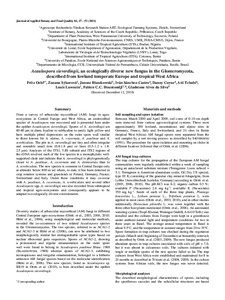| dc.contributor.author | Oehl, F. |
| dc.contributor.author | Sýkorová, Z. |
| dc.contributor.author | Błaszkowski, J. |
| dc.contributor.author | Sánchez-Castro, I. |
| dc.contributor.author | Coyne, D.L. |
| dc.contributor.author | Tchabi, A. |
| dc.contributor.author | Lawouin, L. |
| dc.contributor.author | Hountondji, F.C.C. |
| dc.contributor.author | Silva, G.A. da |
| dc.date.accessioned | 2019-12-04T11:10:36Z |
| dc.date.available | 2019-12-04T11:10:36Z |
| dc.date.issued | 2011 |
| dc.identifier.citation | Oehl, F., Sýkorová, Z., Błaszkowski, J., Sánchez-Castro, I., Coyne, D., Tchabi, A., ... & da Silva, G.A. (2012). Acaulospora sieverdingii, an ecologically diverse new fungus in the Glomeromycota, described from lowland temperate Europe and tropical West Africa. Journal of Applied Botany and Food Quality, 84(1), 47-53. |
| dc.identifier.issn | 1613-9216 |
| dc.identifier.uri | https://hdl.handle.net/20.500.12478/2207 |
| dc.description.abstract | From a survey of arbuscular mycorrhizal (AM) fungi in agroecosystems in Central Europe and West Africa, an undescribed species of Acaulospora was recovered and is presented here under the epithet Acaulospora sieverdingii. Spores of A. sieverdingii are 60-80 μm in diam, hyaline to subhyaline to rarely light yellow and have multiple pitted depressions on the outer spore wall similar to those known for A. alpina, A. cavernata, A. paulinae and A. scrobiculata. The pits in A. sieverdingii are tiny and often irregular and resemble small dots (0.8-1.8 μm) or lines (0.5-1.2 x 1.8-2.5 μm). Analyses of the ITS1, 5.8S subunit and ITS2 regions of the rDNA resolved each of the fi ve species in a monophyletic wellsupported clade and indicate that A. sieverdingii is phylogenetically closer to A. paulinae, A. cavernata and A. denticulata than to A. scrobiculata. The new species is common in Central Europe only at altitudes below 800 m asl where, to date, it has been detected in crop rotation systems and grasslands in Poland, Germany, France, Switzerland and Italy. Under these conditions it may co-occur with A. paulinae, A. cavernata, A. scrobiculata and several other Acaulospora spp. A. sieverdingii was also recorded from subtropical and tropical agro-ecosystems and consequently appears to be adapted to ecologically diverse environments. |
| dc.description.sponsorship | Swiss National Science Foundation |
| dc.description.sponsorship | Swiss Center for International Agriculture |
| dc.description.sponsorship | Swiss Agency for Development and Cooperation |
| dc.language.iso | en |
| dc.subject | Acaulospora |
| dc.subject | Agroecosystems |
| dc.subject | Dna |
| dc.subject | Europe |
| dc.title | Acaulospora sieverdingii, an ecologically diverse new fungus in the Glomeromycota, described from lowland temperate Europe and tropical West Africa |
| dc.type | Journal Article |
| dc.description.version | Peer Review |
| cg.contributor.affiliation | Agroscope Research Station, Switzerland |
| cg.contributor.affiliation | Academy of Sciences of the Czech Republic |
| cg.contributor.affiliation | West Pomeranian University of Technology |
| cg.contributor.affiliation | Université de Bourgogne |
| cg.contributor.affiliation | International Institute of Tropical Agriculture |
| cg.contributor.affiliation | Université de Lomé |
| cg.contributor.affiliation | University of Parakou |
| cg.contributor.affiliation | Universidade Federal de Pernambuco |
| cg.coverage.region | Europe |
| cg.coverage.region | Africa |
| cg.coverage.region | West Africa |
| cg.coverage.country | Poland |
| cg.coverage.country | Germany |
| cg.coverage.country | France |
| cg.coverage.country | Switzerland |
| cg.coverage.country | Italy |
| cg.coverage.country | Benin |
| cg.isijournal | ISI Journal |
| cg.authorship.types | CGIAR and developing country institute |
| cg.iitasubject | Plant Diseases |
| cg.journal | Journal of Applied Botany and Food Quality |
| cg.howpublished | Formally Published |
| cg.accessibilitystatus | Limited Access |
| local.dspaceid | 90938 |

